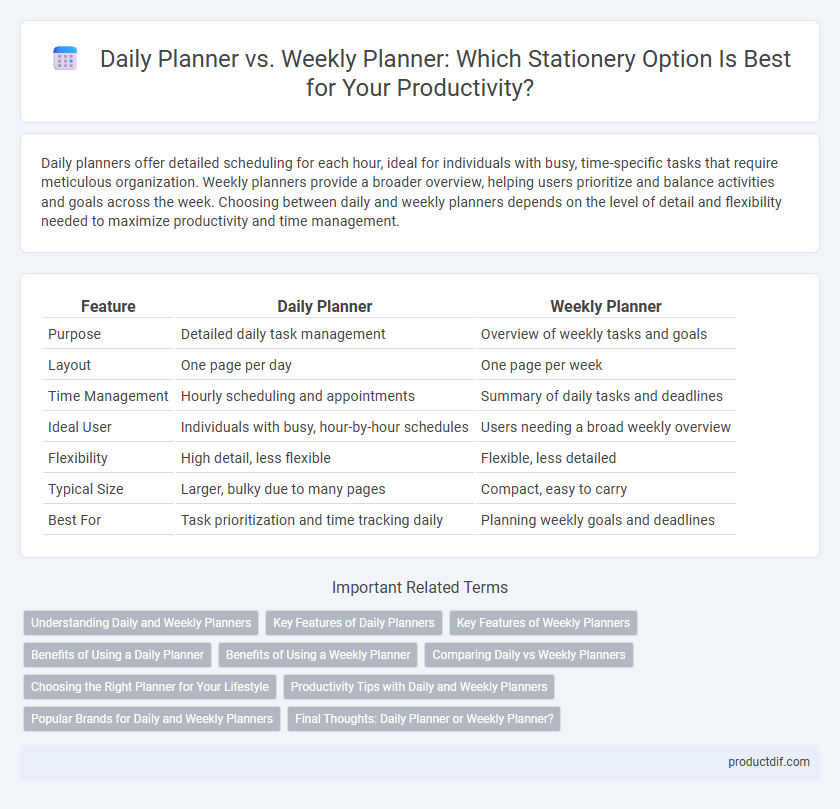Daily planners offer detailed scheduling for each hour, ideal for individuals with busy, time-specific tasks that require meticulous organization. Weekly planners provide a broader overview, helping users prioritize and balance activities and goals across the week. Choosing between daily and weekly planners depends on the level of detail and flexibility needed to maximize productivity and time management.
Table of Comparison
| Feature | Daily Planner | Weekly Planner |
|---|---|---|
| Purpose | Detailed daily task management | Overview of weekly tasks and goals |
| Layout | One page per day | One page per week |
| Time Management | Hourly scheduling and appointments | Summary of daily tasks and deadlines |
| Ideal User | Individuals with busy, hour-by-hour schedules | Users needing a broad weekly overview |
| Flexibility | High detail, less flexible | Flexible, less detailed |
| Typical Size | Larger, bulky due to many pages | Compact, easy to carry |
| Best For | Task prioritization and time tracking daily | Planning weekly goals and deadlines |
Understanding Daily and Weekly Planners
Daily planners provide detailed time management by dividing each day into hourly segments, ideal for individuals with busy schedules requiring precise task allocation. Weekly planners offer a broader overview by organizing activities across seven days on a single spread, facilitating long-term planning and goal tracking. Selecting between daily and weekly planners depends on the user's need for granularity versus an overall view of their commitments.
Key Features of Daily Planners
Daily planners offer detailed scheduling with hourly time slots that help users manage appointments and tasks precisely throughout the day. They typically include sections for to-do lists, prioritization, and notes, enhancing productivity by promoting focused daily goal setting. The compact layout supports thorough tracking of activities, making daily planners ideal for individuals with busy or highly structured routines.
Key Features of Weekly Planners
Weekly planners offer a structured overview of the entire week on a single spread, enhancing time management and goal tracking. Key features include dedicated sections for each day, space for priority tasks, and habit tracking areas, allowing for efficient planning without overwhelming detail. These planners are ideal for balancing multiple appointments and deadlines while maintaining a clear weekly focus.
Benefits of Using a Daily Planner
Using a daily planner enhances productivity by providing detailed scheduling for each day, allowing users to prioritize tasks effectively and manage time efficiently. It facilitates goal tracking and reduces stress through clear visualization of daily commitments, improving accountability and focus. Daily planners also offer flexibility for adjustments and encourage consistent habit formation, leading to sustained personal and professional growth.
Benefits of Using a Weekly Planner
Using a weekly planner enhances time management by providing a clear overview of tasks and appointments across seven days, helping prioritize activities efficiently. It reduces stress and increases productivity through visual organization of deadlines and events, encouraging balanced workload distribution. Weekly planners also promote goal tracking and habit formation by allowing users to monitor progress on weekly objectives systematically.
Comparing Daily vs Weekly Planners
Daily planners provide detailed space for hourly scheduling and task management, ideal for users with busy, time-specific commitments. Weekly planners offer a broader overview of the entire week, helping prioritize tasks and events at a glance without overwhelming detail. Choosing between daily and weekly planners depends on whether precise daily organization or an overall weekly summary best suits individual productivity needs.
Choosing the Right Planner for Your Lifestyle
Daily planners provide detailed scheduling with hour-by-hour time slots, ideal for individuals with busy routines requiring precise task management. Weekly planners offer a broader overview, highlighting key appointments and goals, suitable for those who prefer flexibility and big-picture organization. Selecting the right planner depends on balancing the need for detailed planning against overall time management preferences in your daily life.
Productivity Tips with Daily and Weekly Planners
Daily planners enhance productivity by breaking tasks into manageable, day-specific goals, allowing for focused time-blocking and effective prioritization. Weekly planners provide a broader overview of upcoming deadlines and commitments, facilitating strategic planning and balanced workload distribution across multiple days. Combining both planners helps optimize task management by aligning detailed daily actions with overarching weekly objectives, boosting overall efficiency and goal achievement.
Popular Brands for Daily and Weekly Planners
Popular brands for daily planners include Moleskine, Leuchtturm1917, and Passion Planner, known for their structured layouts and high-quality materials that support detailed scheduling and task management. Weekly planners, favored by brands like Erin Condren, Blue Sky, and Day Designer, offer broader overviews with customizable sections ideal for goal setting and time blocking. Each brand optimizes planner functionality to cater to different productivity styles, ensuring users can effectively organize their time whether focusing on daily specifics or weekly summaries.
Final Thoughts: Daily Planner or Weekly Planner?
Choosing between a daily planner and a weekly planner depends on your scheduling needs and preferred level of detail. Daily planners offer granular task management and time-blocking, ideal for busy individuals with dynamic schedules. Weekly planners provide a broader overview, perfect for balancing multiple projects and long-term planning without overwhelming detail.
Daily planner vs Weekly planner Infographic

 productdif.com
productdif.com